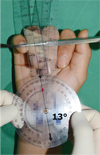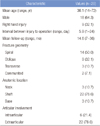Abstract
Purpose
Hand fractures can be treated conservatively in many cases, but rotation malalignment is one of the important indications for surgical treatment because of dysfunction. We performed open reduction and internal fixation in these malalignment fractures and report clinical and radiological results.
Methods
This study included 28 patients (18 male, 10 female) who had metacarpal and phalangeal fractures with rotational malalignment of finger on initial examination. Patients with combined injuries including open soft tissue damage or multiple fractures were excluded. Mean age was 36.1 years and average follow-up period was 14.6 months. Perioperative extent of rotation and correction during the follow-up, union on the radiographs, Range of motion, disability of the arm, shoulder and hand (DASH) score, and pinch power at the last follow-up were evaluated.
Results
Average corrected angulation of rotation was 11.9° and no patient showed scissoring appearance of fingers at the last follow-up. All patients showed solid bony union on the radiographs during the follow-up. The average of total active motion of the injured fingers were average 254°, average DASH score was 3.2 and average pinch power was 3.0 kg at the last follow-up.
Figures and Tables
 | Fig. 2Radiologic measurement methods of anteropaterior angulation (A), saggital angulation (B), and fracture bone height (C). |
 | Fig. 3A 38-year-old woman was injured from traction injury resulting in minimally displaced spiral fracture on left 4th finger proximal phalanx. Initial anteroposterior and oblique plan radiographs (A, B). Physical examination in outpatient clinic presented 4th finger overlapping on 4th finger (C). Intraoperative clinical photo of open reduction and internal fixation (D). Correction of rotational alignment after operation (D). Postoperative AP plain radiographs (E) showed anatomic reduction and proper fixation with two lag screws. |
 | Fig. 4Repeated measures analysis of variance result. Serial measurement represented preoperative and postoperative passive angle measurement under anesthesia and final follow up active angle measurement between convergent and divergent group. |
Notes
This research was supported by a grant of the Korea Health Technology R&D Project through the Korea Health Industry Development Institute (KHIDI), funded by the Ministry of Health & Welfare, Republic of Korea (grant number: HI13C1398) and Bio & Medical Technology Development Program of the National Research Foundation of Korea (NRF) grant funded by the Korean government (MSIP) (No. 2016M3A9E8941670, 2016R1D1A1B03932856).
References
1. Chung KC, Spilson SV. The frequency and epidemiology of hand and forearm fractures in the United States. J Hand Surg Am. 2001; 26:908–915.

3. Balaram AK, Bednar MS. Complications after the fractures of metacarpal and phalanges. Hand Clin. 2010; 26:169–177.

4. Tan V, Kinchelow T, Beredjiklian PK. Variation in digital rotation and alignment in normal subjects. J Hand Surg Am. 2008; 33:873–878.

5. Calandruccio JH, Jobe MT. Fractures, dislocations, and ligamentous injuries. In : Campbell WC, Canale ST, Beaty JH, editors. Campbell's operative orthopaedics. Philadelphia: Mosby/Elsevier;2008. p. 3921–3980.
6. Henry MH. Hand fractures and dislocations. In : Bucholz RW, Rockwood CA, Green DP, editors. Rockwood and Green's fractures in adults. 7th ed. Philadelphia: Lippincott, Williams & Wilkins;2010. p. 711–780.
7. Day CS. Fractures of the metacarpals and phalanges. In : Wolfe SW, Hotchkiss RN, Pederson WC, Kozin SH, Cohen MS, Green DP, editors. Green's operative hand surgery. 7th ed. Philadelphia: Elsevier;2017. p. 231–277.
8. Jupiter JB, Axelrod TS, Belsky MR. Fractures and dislocations fo the hand. In : Browner BD, Green NE, editors. Skeletal trauma: basic science, management, and reconstruction. 3rd ed. Philadelphia: Saunders;2003. p. 1153.
9. Ashkenaze DM, Ruby LK. Metacarpal fractures and dislocations. Orthop Clin North Am. 1992; 23:19–33.

10. Henry MH. Fractures of the proximal phalanx and metacarpals in the hand: preferred methods of stabilization. J Am Acad Orthop Surg. 2008; 16:586–595.

11. Lenoble E, Goutallier D. Reduction and osteosynthesis of displaced fractures of the distal third of the fifth metacarpal with central medullary bone wires. Ann Chir Main Memb Super. 1993; 12:189–195.




 PDF
PDF ePub
ePub Citation
Citation Print
Print







 XML Download
XML Download